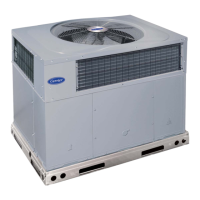
Do you have a question about the Carrier Performance 50VT and is the answer not in the manual?
| SEER2 | Up to 16.5 |
|---|---|
| Refrigerant | R-410A |
| Cooling Capacity (BTU/h) | 60, 000 |
| Heating Capacity (BTU/h) | 60, 000 |
| Voltage | 208/230 |
Highlights key features and benefits of the 50VT heat pump units, including efficiency and ease of installation.
Details the high-efficiency design of the 50VT units, emphasizing SEER ratings.
Explains the environmental benefits and reliability of Puron refrigerant used in the units.
Describes the unit's factory-assembled package and ease of installation.
Defines the unit type as a single packaged heat pump unit.
Lists the nominal cooling capacities for different unit sizes in tons.
Specifies the available electrical supply options for the units.
Lists various factory-installed options available for the units.
Presents cooling capacities, EER, and SEER ratings for different unit sizes.
Details heating capacities, COP, and HSPF for various unit sizes.
Details physical specifications for each unit size, including weight and dimensions.
Indicates the number of compressors per unit.
Specifies the type and quantity of refrigerant used in the units.
Provides specifications for the outdoor coil, including rows, fins per inch, and face area.
Details specifications for the indoor blower, including airflow and size.
Presents sound level data in dBA for different unit sizes and frequencies.
Lists factory-installed options like louver grilles and coil options.
Details various accessories that can be installed in the field.
Explains the function of the economizer for free cooling and reduced compressor operation.
Describes electric heaters for additional heat, noting single-point power supply.
Highlights features of the filter rack for easy installation and serviceability.
Mentions available flat roof curb sizes for roof-mounted applications.
Describes the kit to adapt units to round ductwork.
Details thermostat options for system heating and cooling control.
Explains the crankcase heater's role in preventing floodback.
Describes the start kit for single-phase units to aid compressor start-up.
Details the rigging kit for lifting units during rooftop applications.
Explains the low ambient kit for operation at low outdoor temperatures.
Lists ordering numbers for electric heater modules.
Specifies the power capacity of electric heaters in kW.
Indicates which unit sizes are compatible with each electric heater.
Provides minimum airflow requirements for electric heater operation.
Diagram showing the side view of the economizer installation.
Provides a detailed view of the economizer base and flange.
Illustrates the top filter rack component.
Illustrates the bottom filter rack component.
Shows the hood for the manual outside air damper.
Diagrammatically represents the damper blade.
Diagram showing the top view of the unit dimensions.
Diagram showing the left side view of the unit dimensions.
Diagram showing the front view of the unit dimensions.
Diagram showing the right side view of the unit dimensions.
Diagram showing the rear view of the unit dimensions.
Specifies required clearances for combustible materials.
Details clearances needed for unit operation and servicing.
Diagram showing the top view of the unit dimensions.
Diagram showing the left side view of the unit dimensions.
Diagram showing the front view of the unit dimensions.
Diagram showing the right side view of the unit dimensions.
Diagram showing the rear view of the unit dimensions.
Specifies required clearances for combustible materials.
Details clearances needed for unit operation and servicing.
Dimensions and installation notes for small cabinet roof curbs.
Dimensions and installation notes for large cabinet roof curbs.
Provides important notes regarding roof curb installation and usage.
Lists unit sizes for rigging weight calculation.
Provides shipping weights for small cabinet units.
Provides rigging weights for small cabinet units.
Lists unit sizes for rigging weight calculation.
Provides shipping weights for large cabinet units.
Provides rigging weights for large cabinet units.
Step 1: Identify cooling and heating needs based on design conditions.
Step 2: Choose the unit size matching the required cooling capacity.
Step 3: Determine heating capacity and need for accessory electric heat.
Step 4: Calculate fan speed and power needs based on design conditions.
Step 5: Choose the unit based on available electrical power source.
Provides detailed cooling performance data for the 024 unit size.
Provides detailed cooling performance data for the 030 unit size.
Continued cooling performance data for the 030 unit size.
Heating performance data for the 030 unit size across various temperatures.
Detailed cooling performance data for the 036 unit size.
Heating performance data for the 036 unit size across various temperatures.
Detailed cooling performance data for the 042 unit size.
Heating performance data for the 042 unit size across various temperatures.
Detailed cooling performance data for the 048 unit size.
Heating performance data for the 048 unit size across various temperatures.
Detailed cooling performance data for the 060 unit size.
Heating performance data for the 060 unit size across various temperatures.
Provides essential notes and formulas for interpreting cooling performance data.
Air delivery data for wet coil conditions across various static pressures.
Provides pressure drop values for economizer filters.
Lists multiplication factors for voltage and heater ratings.
Details pressure drop for electric heat in different cabinet sizes.
Presents wet coil pressure drop data for various unit sizes and airflows.
Air delivery data for dry coil conditions across various static pressures.
Diagram illustrating the top cover of the unit.
Shows the return air path in the unit's typical layout.
Indicates the location of the indoor thermostat.
Shows the connection point for the main power source.
Specifies the requirement for a field-supplied condensate trap.
Details the maximum recommended cooling airflow per ton.
Provides minimum cooling airflow recommendations and potential issues.
States minimum ambient temperatures for cooling operation and low ambient kit.
Specifies the maximum operating outdoor air temperature for cooling.
Instructions for securing downflow and horizontal discharge ductwork.
Describes the process of converting the unit for downflow discharge.
Label for the Y-axis of the balance point worksheet.
Label for the X-axis of the balance point worksheet.
Indicates the basis for the data presented on the worksheet.
Table listing unit model numbers.
Specifies the nominal voltage, phase, and frequency for units.
Details compressor electrical specifications like RLA, LRA, FLA.
Lists electrical data for electric heat options.
Provides power supply details including fuse/breaker and MCA/MOCP.
Provides important notes regarding electrical compliance and voltage imbalance.
Illustrates voltage calculation for a 3-phase supply.
Instructions for finding voltage deviation.
Provides the formula for calculating voltage imbalance percentage.
Critical warning regarding supply voltage phase imbalance.
Diagram showing the unit's connection wiring.
Schematic illustrating the electrical logic and component connections.
Defines symbols and abbreviations used in the wiring diagrams.
Information on dip switch settings for unit configuration.
Diagram showing the unit's connection wiring for 3-phase.
Schematic illustrating the electrical logic for 3-phase units.
Defines symbols and abbreviations used in the wiring diagrams.
Information on dip switch settings for unit configuration.
Diagram showing the unit's connection wiring for 460V 3-phase.
Schematic illustrating the electrical logic for 460V 3-phase units.
Information on dip switch settings for unit configuration.
Describes the unit's sequence of operation for power, cooling, and heating.
Explains the sequence of operations during cooling mode.
Explains the sequence of operations during heating mode.
Details the defrost control board and operation, including Quiet Shift.
Provides notes on compressor time delay and defrost control board functionality.
General guide specifications for packaged heat pumps.
Specific guide specifications for the HVAC system.
General information covering system description and quality assurance.
Overview of the air-to-air heat pump unit's design and features.
Details quality standards and certifications the unit meets.
Guidance on proper delivery, storage, and handling of the unit.
Specifications for individual product components.
Details the main equipment components and their features.
General description of the factory-assembled heat pump unit.
Specifications for the unit's cabinet construction and features.
Details about the indoor and outdoor fan specifications.
Specifications for the compressor, including type and isolation.
Details on the construction of indoor and outdoor coils.
Specifies the type of refrigerant metering device used.
Information on the type and size of filters used.
Details on unit controls, safeties, and low-voltage circuits.
Describes operational capabilities under various ambient conditions.
Specifies electrical connection requirements for the unit.
Details on motor types, bearings, and overload protection.
Lists optional features that can be added to the unit.
Instructions for installing flat roof curbs, including seal strip and wood nailer.
Details the manual outdoor air damper package for ventilation.
Specifies thermostat functions for heating and cooling control.
Describes the low ambient package for outdoor fan control.
Information on the filter rack kit for downflow applications.
Details the kit for converting duct openings from rectangular to round.
Explains the crankcase heater for low-load cooling protection.
Details on electric heaters as a field-installed option.
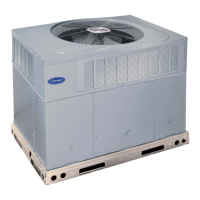
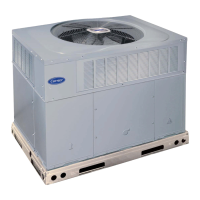
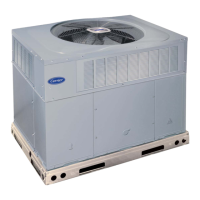
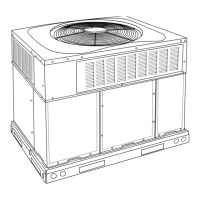
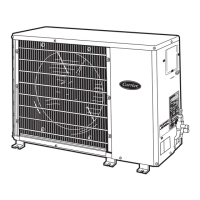
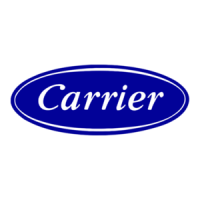

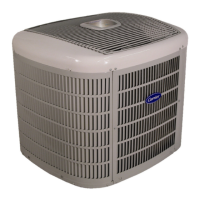
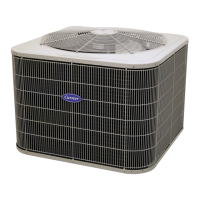
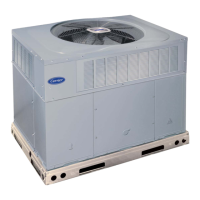
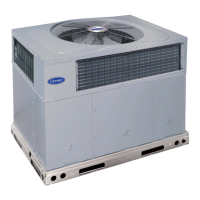
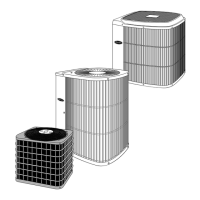
